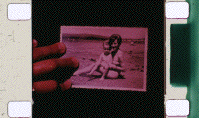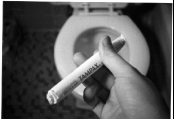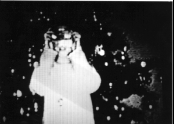

¡Ay Que Pelos! is a 21-minute hand-processed experimental film in both English and Spanish about anxiety disorders and panic attack syndrome. This bilingual film incorporates a variety of source materials -- personal experiences, semi-biographical information, case studies, medical texts and treatment options -- and uses these to examine how the disease has been perceived and (mis)understood by the medical establishment and others. The main focus of the film are the inter-related events of one family of women and the pattern of emotional reactions and actions related via their stories.
The structure of ¡Ay Que Pelos! is aimed at soliciting a filmic experience of panic attack syndrome in the mind of the viewer in order to comprehend the subtleties of the disease. Based on emotional and physical reactions, the visual rhythm builds to induce the sensation of fear in the audience. The Spanish and English texts, both as audio and as visual titles, relate the memories of a bilingual childhood; the events that shaped the narrator's mind and that of her family. The use of negative and positive imagery alongside techniques of direct-animation, hand-colouring, and optical printing, cultivate the dialogue between the rational mind and irrational mind; via the camera-eye and the mind's-eye. In ¡Ay Que Pelos!, mental balance and mental sedation are in conflict; the dilemma of self-control versus control of one's mental state by those in authority.
Images, Text, and Sound: Pia Cseri-Briones
Original Music for Piano Quartet: Damon Lee
Technical Assistance: George M. Ferguson
1996/97, 21 min, 16mm, colour

La Niña, la Pinta, and the Santa Maria is an experimental film folktale about a young girl who gets pregnant unexpectedly as the result of mysterious circumstances. Based on Hungarian folkstories and songs, and the poetry of Sándor Petöfi, this film offers a contemporary tale of changing traditions and female roles as told entirely through the point-of-view of the girl. Shot in a style reminiscent of 1920s surrealist filmmaking, the story describes the mythical meeting between a modern young woman, Erzsebet, and a lost medieval prince seeking the mother for his child; destined to become the next leader of the Magyars. Using black and white, colour, and tinted footage, the film explores the space where reality and myth intersect. An existing problem. A hypothetical situation. It's her affair, after all.
Images, texts & sound: Pia Cseri-Briones
Musical Manipulations of Folksongs: Brian Tibbs
Technical Assistance: George M. Ferguson
Based on Hungarian folkstories and songs and the poetry of Sándor Petöfi.
1994, 17 min, 16mm, black&white and colour

Lost Tribe is a hand-processed optically printed film from original Super-8 material. A moment in memory when I embraced that history which is my own. What was I supposed to become? Rules and rituals and relations. One human minute in static elation, passes and synchronizes in debris.
Oh but I got lost somewhere along the way, Unsettling behaviour documents all that remains. Is this all that remains of a small existence? An ending. A beginning. Alongside bewildering flashes. One human minute in static elation passes and synchronizes in debris. History is not an answer; only a beginning. Or did I simply forget? Kiss me in the shadow of a doubt, kiss me.
Images and text: Pia Cseri-Briones
Music: Fourth Stream
1993, 3 1/2 min, 16mm, black&white

TAPAS, a film about the Spanish Civil War, uses techniques of experimental cinema within a documentary format. This poetic remembrance of the War and its aftermath is told through the voices and stories of various generations of refugees gone to America. It also uses the poetry of Rosalía de Castro, a nineteenth century Galician writer, to blend the different historical events of the film. TAPAS includes old family movies, historical and new footage, and optically printed Super-8 material, in order to guide the audience through layers of history and memory.
Images & texts: Pia Cseri-Briones
Story written with the assistance of Maruxa Briones and Jozsef Cseri
Poetry: "Follas Novas" & "Cantares Galegos" of Rosalía de Castro and traditional Galician music
1990/91, 25 min, 16mm, colour
E-mail me directly: Pia Cseri-Briones
or contact the following distributors:
Canyon Cinema, San Francisco, California, USA.
Canadian Filmmakers Distribution Centre (CFMDC), Toronto, Ontario, Canada.